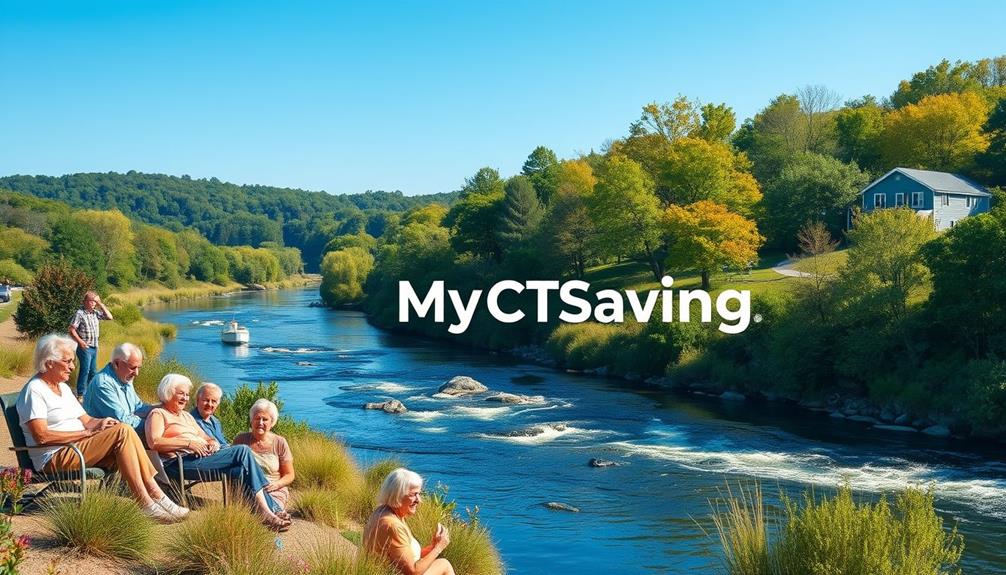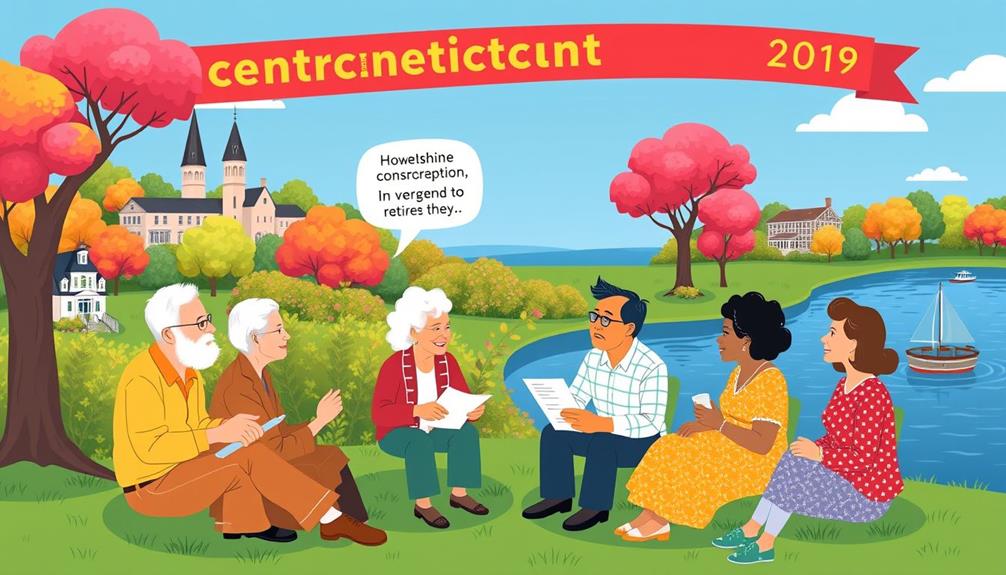When you are planning for retirement in Connecticut, it is important to incorporate IRAs with state-specific benefits such as the MyCTSavings program. This program is designed for employees who do not have employer-sponsored plans and offers a Roth IRA option with automatic 3% enrollment. You have the flexibility to adjust contributions anywhere from 1% to 100% of your earnings, allowing you to build your savings at a pace that suits you. Understanding the distinctions between MyCTSavings and traditional 401(k) plans is crucial. While MyCTSavings simplifies saving, it does not offer employer matches. Examining these alternatives will enable you to maximize your retirement benefits and choose the best path for your future. There is much more to explore about optimizing your retirement strategy!
Key Takeaways
- MyCTSavings provides a state-sponsored Roth IRA option for Connecticut employees without employer-sponsored plans, facilitating retirement savings through automatic payroll deductions.
- The program targets around 600,000 workers in Connecticut, addressing the retirement savings gap through easy enrollment and post-tax contributions.
- Employees can contribute between 1% and 100% of their earnings, with a maximum annual contribution limit of $6,500 ($7,500 for those 50+).
- Unlike 401(k) plans, MyCTSavings does not require employer contributions or matching, focusing on individual employee savings.
- Understanding the differences between MyCTSavings and 401(k) plans is vital for effective retirement planning, as contribution limits and protections vary significantly.
Overview of MyCTSavings Program

The MyCTSavings program is a valuable resource for Connecticut workers, particularly those who often face challenges saving for retirement.
Designed as a retirement savings program, it targets the nearly 600,000 employees without access to employer-sponsored plans. Under this initiative, employees participate through a Roth IRA, making post-tax contributions that are automatically enrolled at a default rate of 3% of their pay. You can adjust your contributions anywhere from 1% to 100%, within IRS limits.
Employers with five or more employees earning over $5,000 annually must participate in MyCTSavings unless they already offer a qualified retirement plan. Compliance deadlines vary based on employer size, ensuring a smooth shift.
The program operates entirely on employee contributions, with an annual asset-based fee of just 0.22% on account balances, plus a $26 annual fee to cover administrative costs—no taxpayer funding is needed.
Benefits of MyCTSavings for Employees

MyCTSavings offers significant advantages for employees looking to secure their financial future. As a state-sponsored Roth IRA, this program allows you to make post-tax contributions, ensuring that your withdrawals during retirement are generally tax-free.
One of the standout features is automatic enrollment, which starts you off at a default contribution rate of 3%. You can easily adjust this rate anywhere from 1% to 100% within IRS limits, making it flexible to fit your financial needs.
With nearly half of Connecticut's workforce currently lacking retirement plan enrollment, MyCTSavings aims to enhance your financial security by promoting higher saving rates through automatic payroll deductions.
After an initial cash preservation period, you'll also gain access to customizable investment options, allowing you to tailor your retirement savings strategy effectively.
Since the program is entirely funded by employee contributions, there are no employer fees involved. This makes MyCTSavings accessible to both for-profit and nonprofit organizations with at least five employees.
Employer Participation Requirements

Employers in Connecticut have a clear obligation to participate in the MyCTSavings program if they meet specific criteria. If you employ five or more workers who earned at least $5,000 in the previous year and don't already offer a qualified retirement plan, you're considered an eligible employer.
The Connecticut Retirement Security Authority has established staggered registration deadlines based on the number of employees you have. Larger employers with 100 or more employees needed to register by June 30, 2022, while smaller employers with 5 to 25 employees faced a deadline of March 30, 2023.
It's important to note that if you already provide a qualified retirement plan, such as a 401(k) or 403(b), you're exempt from the MyCTSavings program.
However, failure to comply with the employer participation requirements can lead to state-imposed penalties, emphasizing your legal obligation to register and participate.
The MyCTSavings program aims to close the retirement savings gap affecting approximately 600,000 workers in Connecticut who currently lack access to employer-sponsored retirement savings.
Contribution Structure and Options

When planning your retirement contributions in Connecticut, it's important to understand the limits and options available to you.
You can benefit from automatic payroll deductions, which make saving easier, and choose from various investment options to grow your savings effectively.
Additionally, consider the advantages of rolling over a 401k to a Gold IRA for potential tax benefits and inflation protection, as outlined in IRA Rollover to Gold.
With the right contribution strategy, you can maximize your retirement potential while staying within IRS guidelines.
Contribution Limits Overview
Understanding the contribution limits for various retirement accounts is essential for effective retirement planning. For 2023, if you're investing in a Roth IRA, you can contribute up to $6,500, with an additional catch-up contribution of $1,000 available if you're 50 or older.
The contribution limits for a 401(k) plan are even higher, allowing you to contribute up to $22,500 or $30,000 if you qualify for catch-up contributions.
If you participate in MyCTSavings, you'll start with a default enrollment rate of 3%, but you can adjust your contribution anywhere from 1% to 100% of your earnings, as long as you stay within IRS limits.
Remember that MyCTSavings operates as a Roth IRA, meaning all contributions are made with post-tax dollars. This setup allows for tax-free withdrawals in retirement, enhancing your overall retirement savings strategy.
After an initial cash preservation period, you can also customize your investment options within MyCTSavings, which can help grow your retirement funds more effectively.
Knowing these contribution limits guarantees you maximize your savings potential and secure a comfortable retirement.
Payroll Deduction Benefits
MyCTSavings offers payroll deduction benefits that simplify your retirement savings process. As a Connecticut worker, you can take advantage of automatic payroll deductions, making it easier to build your retirement nest egg. The program automatically enrolls you at a default contribution rate of 3% of your gross income, but you can adjust it anywhere between 1% and 100%, within IRS limits. Contributions are made post-tax, allowing you to benefit from Roth IRA features, including tax-free withdrawals during retirement.
Here's a quick overview of the key aspects of MyCTSavings:
| Feature | Description | Importance |
|---|---|---|
| Default Contribution Rate | 3% (adjustable between 1%-100%) | Encourages employee participation |
| Contribution Type | Roth IRA (post-tax) | Allows for tax-free withdrawals |
| Eligibility Requirements | 19 years+, 120 days of employment | Guarantees qualified Connecticut workers are included |
| Savings Rates | Automatic, encourages higher savings | Addresses needs of those lacking employer plans |
| Investment Options | Customizable after cash preservation | Promotes diversified retirement savings |
Investment Options Available
Steering your investment options within the MyCTSavings program can greatly enhance your retirement planning. As a participant, your contributions are made through automatic payroll deductions, starting at a default rate of 3%. You can adjust this between 1% to 100%, staying within IRS guidelines.
MyCTSavings operates as a Roth IRA, allowing you to make post-tax contributions, which means you'll enjoy tax-free withdrawals during retirement.
After an initial cash preservation period, you'll have the flexibility to customize your investment choices. This includes a variety of investment options, such as target-date portfolios that automatically adjust their risk based on your retirement timeline.
For the 2023 tax year, contribution limits for Roth IRAs under MyCTSavings are set at $6,500 annually, or $7,500 if you're aged 50 or over.
Evaluating Retirement Plan Alternatives

When considering retirement plan alternatives in Connecticut, it's essential to evaluate the features and benefits of each option available.
Two primary choices are MyCTSavings and traditional 401(k) plans. Here's what you should keep in mind:
- Contribution Limits: MyCTSavings has lower limits at $6,500 (or $7,500 if you're 50+), while 401(k) plans allow for higher contributions and greater flexibility.
- Automatic Enrollment: MyCTSavings features automatic enrollment at 3%, making it easier to start saving, compared to the varying options available in 401(k) plans.
- Employer Matching Contributions: Unlike 401(k) plans, MyCTSavings doesn't allow for employer matching contributions, which can enhance your retirement savings considerably.
- ERISA Protections: 401(k) plans come with ERISA protections that safeguard your investments, whereas MyCTSavings lacks these federal protections, making it riskier.
Common Misconceptions About Retirement Plans

When it comes to retirement plans, you might be misinformed about key aspects like tax benefits and contribution limits.
Many people mistakenly think they'll get immediate tax breaks from Roth IRAs or assume that employer contributions are standard in state-sponsored plans.
Understanding these misconceptions can help you make better financial decisions for your future.
Misunderstanding Tax Benefits
Misunderstandings about tax benefits can greatly impact your retirement planning. Many people confuse how different retirement accounts work, especially IRAs and 401(k)s. Here are four common misconceptions that could affect your strategy:
- Roth IRA Contributions: You might think contributions provide immediate tax benefits, but they're made with post-tax dollars. This means withdrawals during retirement are generally tax-free, offering a different kind of tax benefit.
- Contribution Limits: Not all retirement plans share the same tax rules. Roth IRAs have lower contribution limits ($6,500; $7,500 if you're 50+) compared to 401(k)s ($22,500; $30,000 if you're 50+), which can influence your financial planning.
- Adjusting Contributions: If you're enrolled in a state-sponsored plan like MyCTSavings, you can change your contribution amounts. Many assume they can't, but you can adjust between 1% to 100% within IRS limits.
- Employer Contributions: It's a common belief that employers must contribute to retirement accounts. However, MyCTSavings doesn't require matching contributions, impacting potential tax benefits.
Understanding these nuances can enhance your retirement income strategy.
Contribution Limits Confusion
Maneuvering the maze of retirement plan contribution limits can be tricky, especially when it comes to understanding the differences between various accounts. For instance, while you can contribute up to $6,500 to a Roth IRA each year (or $7,500 if you're over 50), that's considerably less than the $22,500 limit for 401(k) plans.
Many people mistakenly think employer contributions can be made to Roth IRAs, but in the MyCTSavings program, that's not allowed.
It's also vital to grasp the tax benefits of each type of account. Traditional IRAs give you tax deductions upfront, while Roth IRAs let you withdraw funds tax-free during retirement.
Some workers assume they're automatically eligible to contribute to Roth IRAs, but income limits can restrict higher earners.
Lastly, don't confuse the flexibility of different retirement plans. MyCTSavings operates under state-sponsored rules that differ from standard 401(k) plans, making it essential to understand the specific contribution limits and conditions of each option.
Employer Responsibilities Misconceptions
Many employers hold misconceptions about their responsibilities within the MyCTSavings program, often leading to confusion and potential penalties. Understanding your obligations is essential to avoid costly mistakes. Here are four common misconceptions:
- Participation is Optional: If you have five or more employees and don't offer a qualified retirement plan, enrolling in MyCTSavings is mandatory.
- Avoiding Penalties: Ignoring registration doesn't shield you from non-compliance penalties; state investigations can lead to costly fines.
- Employer Fees: You might think participating incurs fees, but MyCTSavings is funded solely by employee contributions, with no costs falling on you.
- Fiduciary Responsibilities: Many believe they've fiduciary responsibilities under the program, but you're granted immunity regarding investment decisions and plan design.
To successfully navigate retirement planning within the Connecticut Retirement Security Program, make sure you're familiar with employee enrollment disclosures, which must be provided within 30 days of hire.
The Retirement Savings Gap in Connecticut

In Connecticut, around 600,000 workers are missing out on the benefits of employer-sponsored retirement plans, creating a significant savings gap that affects nearly half of the state's workforce. This gap highlights the urgent need for effective retirement planning, especially among small to midsized businesses that often don't provide retirement benefits.
State-sponsored initiatives like MyCTSavings aim to narrow this gap by implementing automatic payroll deductions for employees who lack access to traditional retirement plans. However, participation rates remain low, leaving many workers vulnerable in their later years.
Here's a quick look at the current situation:
| Factor | Details |
|---|---|
| Workers Without Retirement Plans | 600,000 |
| Percentage of Workforce Affected | Nearly 50% |
| Small to Midsized Businesses | Major contributors to low participation |
| MyCTSavings Implementation | Introduces automatic payroll deductions |
| Urgency for Improved Access | Increased reliance on social services |
Improving access to retirement savings options is essential for the Connecticut workforce. By addressing this savings gap, we can help guarantee that more workers have the opportunity to secure their financial futures.
Frequently Asked Questions
What Is the CT State Sponsored Retirement Plan?
The CT State Sponsored Retirement Plan, MyCTSavings, helps you save for retirement through automatic payroll deductions. If your employer doesn't offer a qualified plan, you're automatically enrolled, starting with a 3% contribution from your pay.
What Are the Retirement Rules for the State of Connecticut?
Connecticut's retirement rules require employers with five or more employees to participate in MyCTSavings. If you're eligible, you'll automatically save 3% through payroll deductions into a Roth IRA for tax-free future withdrawals.
What Is the State 403B in Ct?
The State 403(b) in Connecticut lets you save for retirement through pre-tax contributions. You can invest in various options, and if you're over 50, you can contribute even more to boost your savings.
What Is the State of Connecticut 457 Plan?
The Connecticut 457 Plan lets you save for retirement through tax-deferred contributions directly from your paycheck. You can choose from various investment options, and you can access your funds without penalties under certain conditions.
Conclusion
In summary, integrating IRAs with Connecticut's MyCTSavings program can really boost your retirement planning. Did you know that nearly 45% of workers in Connecticut aren't saving for retirement? By participating in MyCTSavings, you not only secure your financial future but also help close that gap. Remember, taking advantage of state-specific benefits can make a significant difference in your savings journey. So, start planning today to guarantee you're on the right path toward a comfortable retirement!










